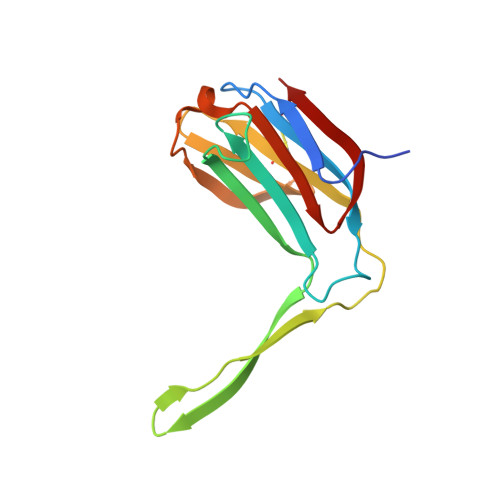Structure-function studies of galectin-14, an important effector molecule in embryology.
Si, Y., Li, Y., Yang, T., Li, X., Ayala, G.J., Mayo, K.H., Tai, G., Su, J., Zhou, Y.(2021) FEBS J 288: 1041-1055
- PubMed: 32525264
- DOI: https://doi.org/10.1111/febs.15441
- Primary Citation of Related Structures:
6K2Y, 6K2Z - PubMed Abstract:
The expression of prototype galectin-14 (Gal-14) in human placenta is higher than any other galectin, suggesting that it may play a role in fetal development and regulation of immune tolerance during pregnancy. Here, we solved the crystal structure of dimeric Gal-14 and found that its global fold is significantly different from that of other galectins with two β-strands (S5 and S6) extending from one monomer and contributing to the carbohydrate-binding domain of the other. The hemagglutination assay showed that this lectin could induce agglutination of chicken erythrocytes, even though lactose could not inhibit Gal-14-induced agglutination activity. Calorimetry indicates that lactose does not interact with this lectin. Compared to galectin-1, galectin-3, and galectin-8, Gal-14 has two key amino acids (a histidine and an arginine) in the normally conserved, canonical sugar-binding site, which are substituted by glutamine (Gln53) and histidine (His57), thus likely explaining why lactose binding to this lectin is very weak. Lactose was observed in the ligand-binding site of one Gal-14 structure, most likely because ligand binding is weak and crystals were allowed to grow over a long period of time in the presence of lactose. We also found that EGFP-tagged Gal-14 is primarily localized within the nucleus of different cell types. In addition, Gal-14 colocalized with c-Rel (a member of NF-κB family) in HeLa cells. These findings indicate that Gal-14 might regulate signal transduction pathways through NF-κB hubs. Overall, the present study provides impetus for further research into the function of Gal-14 in embryology.
- Engineering Research Center of Glycoconjugates Ministry of Education, Jilin Provincial Key Laboratory of Chemistry and Biology of Changbai Mountain Natural Drugs, School of Life Sciences, Northeast Normal University, Changchun, China.
Organizational Affiliation:
















